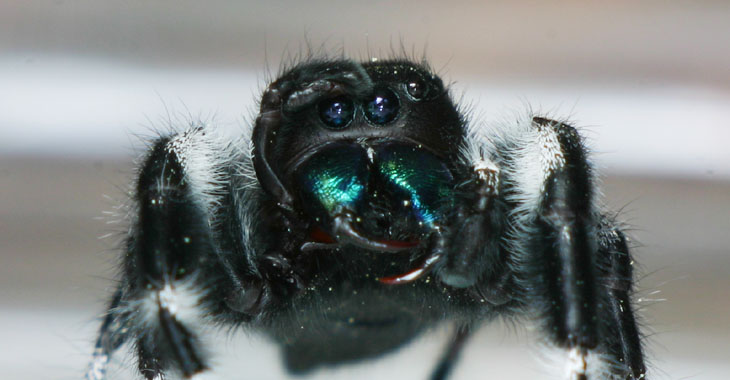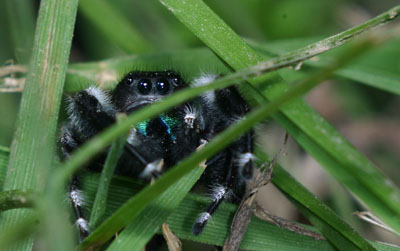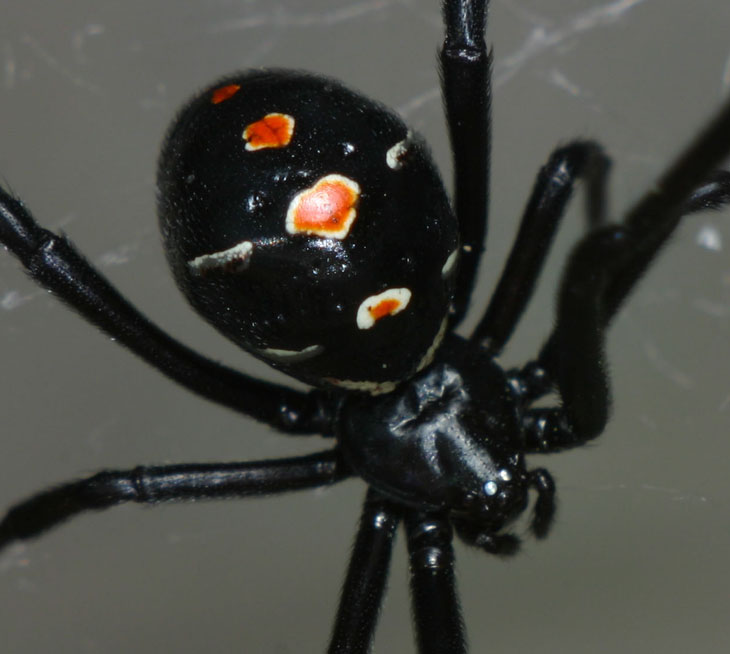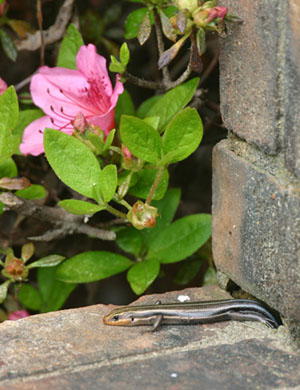
Aw, c’mon! Some titles you can’t resist!
This jumping spider (genus Phidippus, perhaps a Phidippus audax) produced a great pose while I was working with it, appearing to salute with its pedipalp, or maybe shield its eyes form the sun. In reality, it was cleaning its eyes, perhaps trying to wipe away the spots in its vision from my strobes going off right in its face. I have no idea if spiders get those kind of after-images or not, and its entirely possible no one does.
 But I have to say, if you want a straight-on face angle on a spider, go for the jumpers – they have no problem with staring you down. They can’t quite be said to be fearless, but they prefer by far to directly face the threats that loom, and if real danger doesn’t make itself known within a few seconds, they often return to their business, providing the inspiration for stop-motion animation. They don’t walk, they simply blink into a new position slightly different from the previous one.
But I have to say, if you want a straight-on face angle on a spider, go for the jumpers – they have no problem with staring you down. They can’t quite be said to be fearless, but they prefer by far to directly face the threats that loom, and if real danger doesn’t make itself known within a few seconds, they often return to their business, providing the inspiration for stop-motion animation. They don’t walk, they simply blink into a new position slightly different from the previous one.
The pedipalps mentioned earlier are an additional set of limbs – in spiders they’re much like small legs, right alongside the chelicerae (fangs) – which may be used for sensing or food manipulation, and in males, they also serve as the method of impregnating females, having sperm deposited within them to then be inserted into the female. Dude! You eat with those things…
I like how some images can betray a lot about how they were taken, and I often look for details like this. Note the reflections in the eyes of this full-resolution crop:

The spots to the upper left are from the sun itself, but the triangular blob is the softbox on my strobe, a Lumiquest Big Bounce angled forward to provide diffuse lighting from above, and the dot below that is a mini slave strobe (triggered by detecting the light from the main strobe) strapped right to the lens, that fills in direct lighting and some shadow detail. Pay attention to such things when you see closeup photos, and you can often tell how many light sources a photographer is using, or whether they used a ring-flash.
The lighting rig was one of numerous options I tried while chasing another subject. I caught a second black widow just a few days ago, this one a northern variant (Lactrodectus variolus,) which makes sense in that I found it about 20 meters north of the previous one – it would seem the Mason-Dixon line for spiders runs right through the yard. I retained this one in an attempt to do some extreme detail images, but unlike the jumpers, widows aren’t terribly fond of facing the camera. Overnight she’d constructed a typical web of random strands in the jar I was keeping her within, but the only way to get a clear view was through the opening at the top, and she simply wasn’t ready to smile for the camera. With many attempts, I managed to snag the image below, which is clickable if you want the full effect:

While this didn’t quite show the pedipalps detail and chelicerae that I was after, I did at least catch the eyes, reflecting the flash so brightly, and the ventral markings are very distinct. The softbox controlled the reflections from the shiny black body very well, preventing contrasty bright spots, and shows some of the chitin contours. I can live with it. Okay, maybe I should have phrased that differently…
I could arrange the lighting and poses however I liked for dead specimens, which isn’t uncommon in entomology, but that’s not my approach. It’s just a personal thing, since I prefer working with live subjects despite the additional challenges; meanwhile, other photographers won’t even use captive subjects or arranged settings like I do sometimes, so it’s all a matter of taste. My in situ photos of this spider when I found her don’t show very much detail, since she was deep in a crevice of leaves and rocks and largely in shadow. I suppose I could train an assistant spider to manipulate a tiny studio strobe or reflector in such circumstances…
 While i would prefer not to have too many arthropod photos here, I’m just going with what presents itself immediately at hand, and I’m in an area that’s a little too urbanized for bears and wombats. But I’m keeping an eye on my neighbor red-shouldered hawks, quite certain there are eggs in the nest now, and a five-lined skink has been making appearances in the morning on the front steps. I’m unsure if this is a Common (American, Plestiodon fasciatus) or a Southeastern variant (Plestiodon inexpectatus); the genus Plestiodon is apparently now preferred over the former Eumeces for these species. While the scientific names are preferred for accuracy over the ‘common’ or even colloquial names, which tend to be repeated for many species and can be specific to a particular culture, it would help if scientists wouldn’t keep changing them. It would help even more if they didn’t insist on bastardizing a dead language and stuck with something pronounceable. Those elite ivory-towerers!
While i would prefer not to have too many arthropod photos here, I’m just going with what presents itself immediately at hand, and I’m in an area that’s a little too urbanized for bears and wombats. But I’m keeping an eye on my neighbor red-shouldered hawks, quite certain there are eggs in the nest now, and a five-lined skink has been making appearances in the morning on the front steps. I’m unsure if this is a Common (American, Plestiodon fasciatus) or a Southeastern variant (Plestiodon inexpectatus); the genus Plestiodon is apparently now preferred over the former Eumeces for these species. While the scientific names are preferred for accuracy over the ‘common’ or even colloquial names, which tend to be repeated for many species and can be specific to a particular culture, it would help if scientists wouldn’t keep changing them. It would help even more if they didn’t insist on bastardizing a dead language and stuck with something pronounceable. Those elite ivory-towerers!
On the subject of common names, I once conversed with an animal control officer who was recounting an argument he’d had with someone else: “She said we don’t have buzzards around here, but I see them all the time!” I was forced to point out that his opponent was correct – the large scavenger birds in the area are vultures, not buzzards; once a term gets into the language it’s difficult to keep correcting it. And the more rural you are, the more colloquial the names become, such as “chicken hawk” for red-tailed hawks and “sparrow hawk” for kestrels – I’m not even going to bring up the insects.



















































